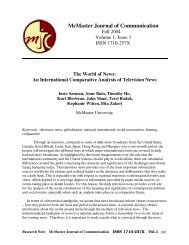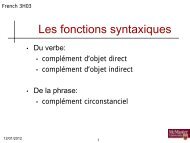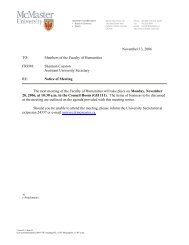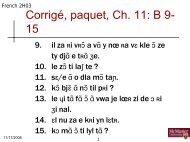The Syntax of Givenness Ivona Kucerová
The Syntax of Givenness Ivona Kucerová
The Syntax of Givenness Ivona Kucerová
Create successful ePaper yourself
Turn your PDF publications into a flip-book with our unique Google optimized e-Paper software.
(31) Derivation <strong>of</strong> [Subject]-G verb-G Object<br />
vP<br />
Subject G<br />
vP<br />
v-G<br />
VP<br />
t V<br />
Object<br />
<strong>The</strong> logic that arises is the following: if a structure is monotonous in the sense that there is<br />
no point where a new element would asymmetrically c-command a given element, syntax<br />
does not have any tool to mark what part exactly is given and what part exactly is new. In<br />
contrast, if there is any deviance from the basic word order, the partition between given<br />
and new is syntactically realized. Thus, the interpretation <strong>of</strong> the utterance is restricted by<br />
syntactic tools. I will argue in chapter 4 that if there is no G-movement, the partition is<br />
established by the semantic component.<br />
I argue that any basic word order sentence – if presented out <strong>of</strong> the blue – is ambiguous<br />
with respect to its information structure. Since there is no syntactic marking <strong>of</strong> the partition<br />
between given and new within basic word order determining the partition is left entirely to<br />
the semantic interface. I argue that this follows from the fact that in a neutral word order<br />
sentence there is no G-movement taking place. Thus the syntactic output <strong>of</strong> such a sentence<br />
is identical no matter how many semantic interpretations <strong>of</strong> the sentence are available.<br />
This conclusion is supported by the fact that there is no difference in prosody between<br />
(27-a) and (30-a). If we assume that phonology reads prosody directly <strong>of</strong>f the syntactic<br />
structure (see, for example, Bresnan 1972; Truckenbrodt 1995; Wagner 2005; Büring 2006,<br />
among many others) this is an unsurprising result. <strong>The</strong>refore, it is only the semantic component<br />
that may interpret such a clause in different ways depending on the actual context.<br />
For syntax and the syntax-phonology interface there is only one structure to be considered.<br />
Crucially, this behavior is a consequence <strong>of</strong> G-movement being a last resort operation. If G-<br />
movement had to take place whenever there was something potentially given, the semantic<br />
(but also word order and prosodic) ambiguity <strong>of</strong> the basic word order would be unexpected.<br />
In this section, we have seen that there is a close connection between the last resort<br />
character <strong>of</strong> G-movement and the multiple interpretations available for basic word orders.<br />
In the next section we will look at ambiguities that arise within derived orders. I will argue<br />
that this type <strong>of</strong> ambiguity follows from G-movement being dependent on head movement.<br />
1.3 Verb partitions and their semantic ambiguity<br />
In Czech the partition between given and new is <strong>of</strong>ten manifested by a finite verb. <strong>The</strong><br />
fact that Czech verbs usually appear between the given and the new part has already been<br />
observed by Vilém Mathesius (Mathesius, [1929] 1983, 1939). In the following Czech<br />
22

















